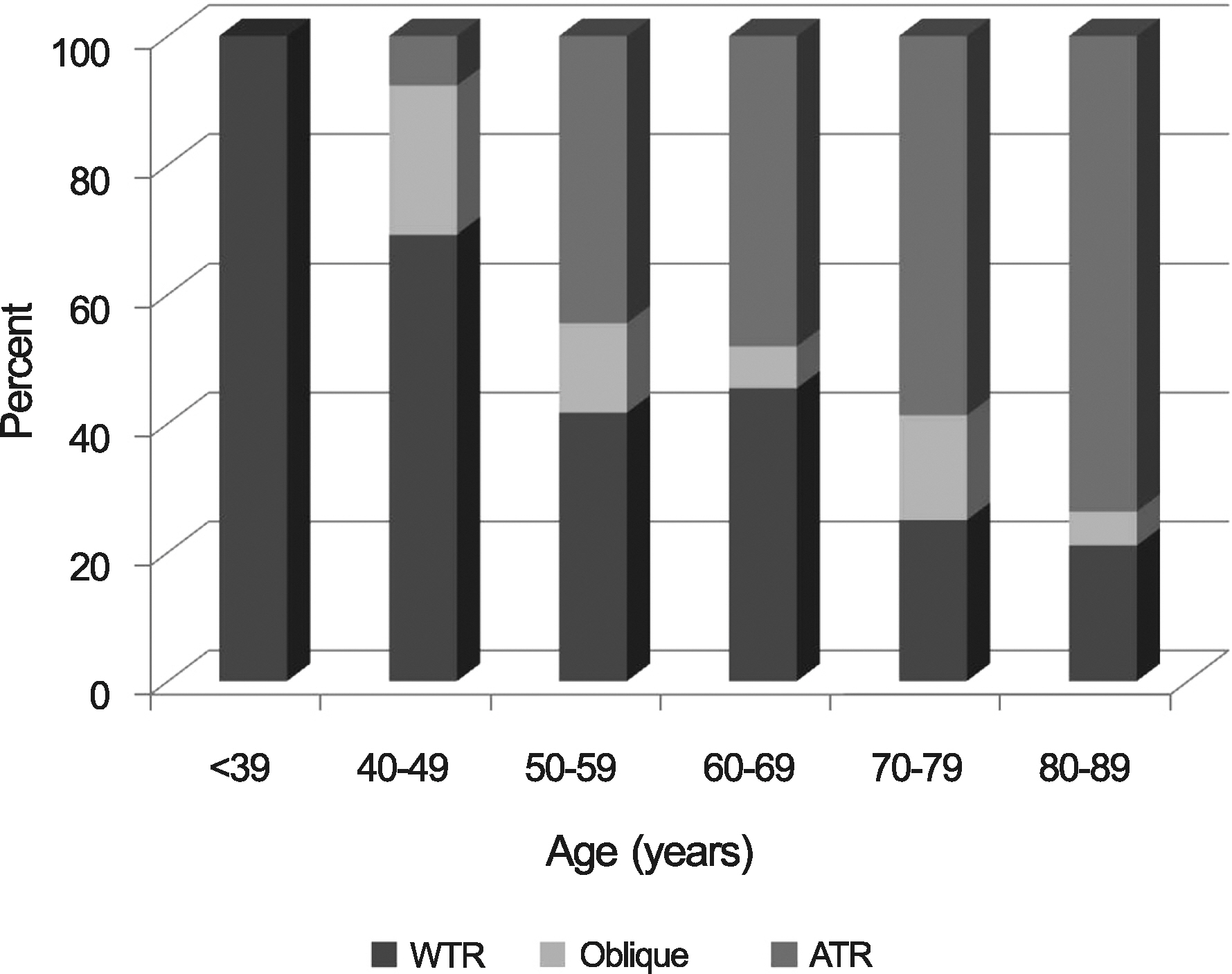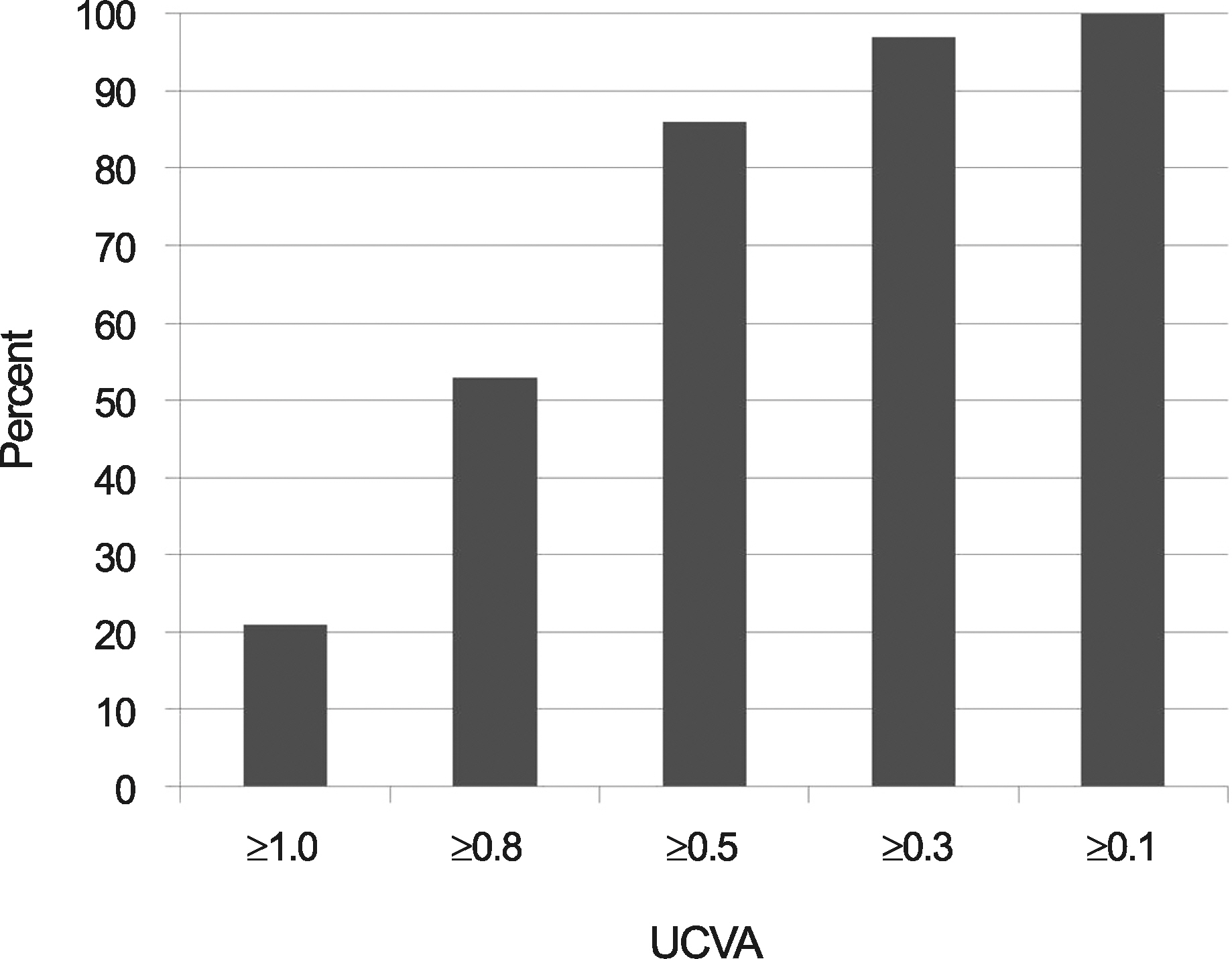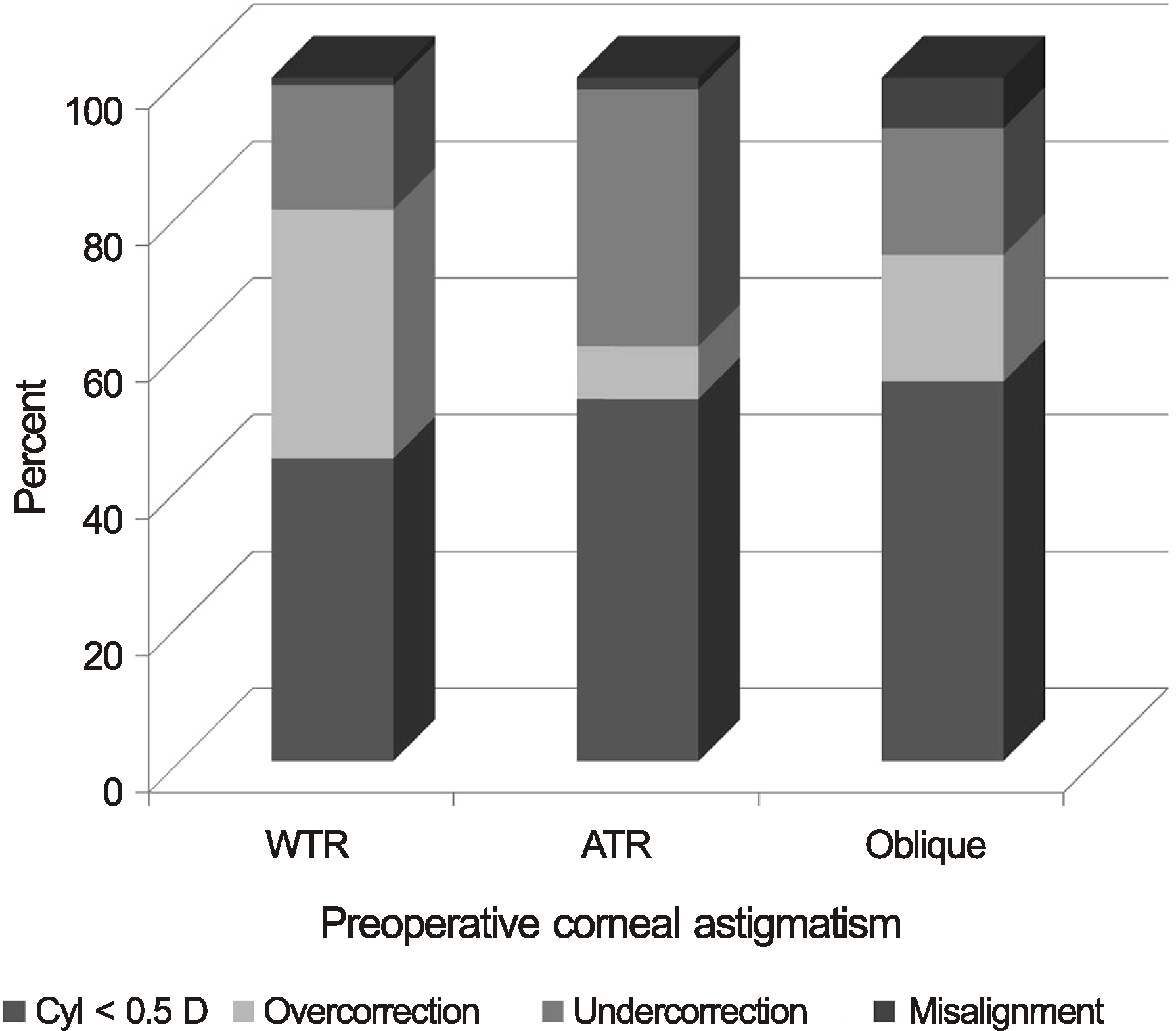J Korean Ophthalmol Soc.
2014 Nov;55(11):1636-1641. 10.3341/jkos.2014.55.11.1636.
Analysis of Miscorrection after Implantation of the Toric Intraocular Lens
- Affiliations
-
- 1Busan Sungmo Eye Hospital, Busan, Korea. sungmobusan@hanmail.net
- KMID: 2216612
- DOI: http://doi.org/10.3341/jkos.2014.55.11.1636
Abstract
- PURPOSE
To evaluate the efficacy and stability of AcrySof Toric intraocular lens (IOL) implants and to analyze the miscorrection that resulted after implantation.
METHODS
This retrospective study included 422 eyes of 348 patients who underwent cataract surgery with implantation of the AcrySof toric IOL between December 2011 and June 2013. We evaluated uncorrected visual acuity (UCVA), best corrected visual acuity (BCVA), keratometry and refraction preoperatively and 3 months postoperatively. The axis of implanted AcrySof Toric IOL was measured using the KR-1W aberrometer before mydriasis. At 3 months postoperatively, patients with a residual cylindrical power of 0.50 diopters (D) or more, and having an IOL rotation of 10 degrees (degrees) or more were considered having miscorrection.
RESULTS
UCVA (log MAR) improved from 0.58 +/- 0.35 to 0.18 +/- 0.26. Preoperative corneal astigmatism was 1.46 +/- 0.72 D and postoperative refractive cylindrical power was 0.45 +/- 0.30 D. The postoperative miscorrection was 50.5% in the T3 group, 35.7% in the T4 group, and 27.2% in the T5 group. The incidence of overcorrection was significantly higher in the T3 group than in the T4 and T5 group. In eyes with with-the-rule (WTR) astigmatism, overcorrection was found in 36.4% (32/88 eyes), while in eyes with against-the-rule (ATR) astigmatism, undercorrection was found in 37.6% of cases (44/117 eyes). There were five cases of IOL rotation at 3 months postoperatively.
CONCLUSIONS
AcrySof Toric IOL was effective in correcting corneal astigmatism and had good rotational stability. However, the incidence of miscorrection, especially for overcorrection, was higher with lower power toric IOL. Patients with WTR astigmatism tend to have overcorrection, while those with ATR show a tendency toward undercorrection, suggesting that these changes considered at the time of cataract surgery.
MeSH Terms
Figure
Cited by 1 articles
-
Effect of Toric Intraocular Lens Implantation on Astigmatism in Cataract Surgery
Yong Jae Cha, Mee Kum Kim, Won Ryang Wee
J Korean Ophthalmol Soc. 2015;56(10):1544-1551. doi: 10.3341/jkos.2015.56.10.1544.
Reference
-
References
1. Hoffmann PC, Auel S, Hütz WW. Results of higher power toric intraocular lens implantation. J Cataract Refract Surg. 2011; 37:1411–8.
Article2. Ferrer-Blasco T, Montés-Micó R, Peixoto-de-Matos SC, et al. Prevalence of corneal astigmatism before cataract surgery. J Cataract Refract Surg. 2009; 35:70–5.
Article3. Singh A, Pesala V, Garg P, Bharadwaj SR. Relation between uncorrected astigmatism and visual acuity in pseudophakia. Optom Vis Sci. 2013; 90:378–84.
Article4. Amesbury EC, Miller KM. Correction of astigmatism at the time of cataract surgery. Curr Opin Ophthalmol. 2009; 20:19–24.
Article5. Poll JT, Wang L, Koch DD, Weikert MP. Correction of astigmatism during cataract surgery: toric intraocular lens compared to peripheral corneal relaxing incisions. J Refract Surg. 2011; 27:165–71.
Article6. Mendicute J, Irigoyen C, Aramberri J, et al. Foldable toric intraocular lens for astigmatism correction in cataract patients. J Cataract Refract Surg. 2008; 34:601–7.
Article7. Na JH, Lee HS, Joo CK. The clinical result of acrySof toric intraocular lens implantation. J Korean Ophthalmol Soc. 2009; 50:831–8.
Article8. De Silva DJ, Ramkissoon YD, Bloom PA. Evaluation of a toric intraocular lens with a Z-haptic. J Cataract Refract Surg. 2006; 32:1492–8.
Article9. Shimizu K, Misawa A, Suzuki Y. Toric intraocular lenses: correcting astigmatism while controlling axis shift. J Cataract Refract Surg. 1994; 20:523–6.
Article10. Werblin TP. Do three-piece PMMA IOLs rotate after implantation in the capsular bag? J Refract Surg. 1995; 11:468–71.
Article11. Gills JP, Martin RG. Sutureless cataract surgery: an evolution toward minimally invasive technique. Thorofare, NJ: Slack Inc;1992. p. 183–97.12. Martin RG, Thornton SP, Sanders DR. Surgical treatment of astigmatism. Thorofare, NJ: Slack Inc;1994. p. 159–64.13. Kim SW, Han SY, Lee KH. The efficacy of KR-1W aberrometer in assessing the astigmatism after toric intraocular lens implantation. J Korean Ophthalmol Soc. 2012; 53:1603–8.
Article14. Kim MH, Chung TY, Chung ES. Long-term efficacy and rotational stability of acrySof toric intraocular lens implantation in cataract surgery. Korean J Ophthalmol. 2010; 24:207–12.
Article15. Sun XY, Vicary D, Montgomery P, Griffiths M. Toric intraocular lenses for correcting astigmatism in 130 eyes. Ophthalmology. 2000; 107:1776–81. discussion 1781-2.
Article16. Chang DF. Early rotational stability of the longer Staar toric intraocular lens: fifty consecutive cases. J Cataract Refract Surg. 2003; 29:935–40.17. Chang DF. Comparative rotational stability of single-piece open-loop acrylic and plate-haptic silicone toric intraocular lenses. J Cataract Refract Surg. 2008; 34:1842–7.
Article18. Lee KH, Kim NR, Seo KY. Comparison of the refractive outcomes according to the differences of biometry and keratometry reading. J Korean Ophthalmol Soc. 2013; 54:1345–52.
Article19. Chang MW, Kang SY, Kim HM. Which keratometer is most reliable for correcting astigmatism with toric intraocular lenses? Korean J Ophthalmol. 2012; 26:10–4.
Article20. Koch DD, Ali SF, Weikert MP, et al. Contribution of posterior corneal astigmatism to total corneal astigmatism. J Cataract Refract Surg. 2012; 38:2080–7.
Article21. Hasegawa Y, Okamoto F, Nakano S, et al. Effect of preoperative corneal astigmatism orientation on results with a toric intraocular lens. J Cataract Refract Surg. 2013; 39:1846–51.
Article22. Ho JD, Liou SW, Tsai RJ, Tsai CY. Effects of aging on anterior and posterior corneal astigmatism. Cornea. 2010; 29:632–7.
Article23. Hayashi K, Hirata A, Manabe S, Hayashi H. Long-term change in corneal astigmatism after sutureless cataract surgery. Am J Ophthalmol. 2011; 151:858–65.
Article
- Full Text Links
- Actions
-
Cited
- CITED
-
- Close
- Share
- Similar articles
-
- The Efficacy of KR-1W Aberrometer in Assessing the Astigmatism after Toric Intraocular Lens Implantation
- Scleral Fixation of a Single-Piece AcrySof Toric Intraocular Lens: A Case Report
- Modified Capsular Tension Ring Scleral Fixation and Toric Intraocular Lens Implantation in a Patient with Homocystinuria
- Comparison of Efficacies in Treating Astigmatism between Toric Intraocular Lens Implantation and Limbal Relaxing Incision
- Intraindividual Comparison of ICL and Toric ICL Implantation in the Correction of High Myopia With Astigmatism




